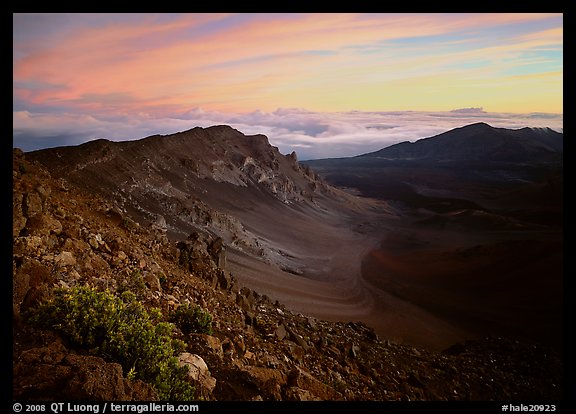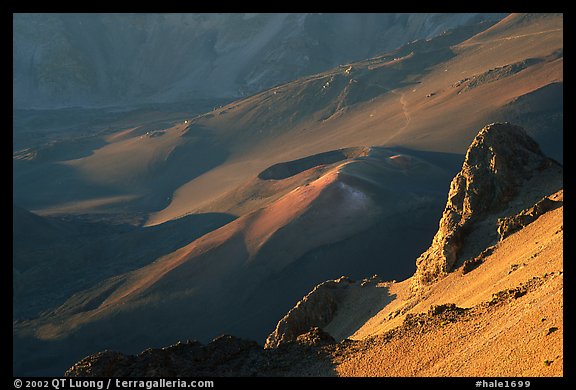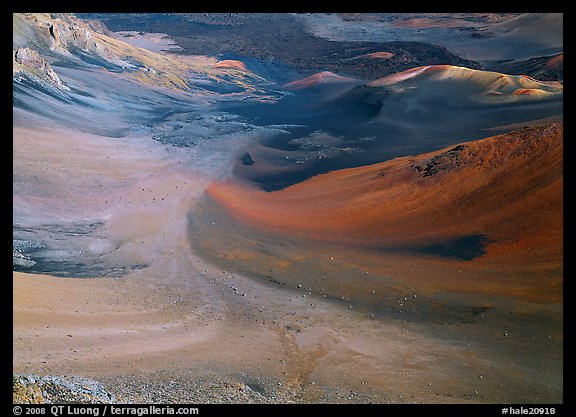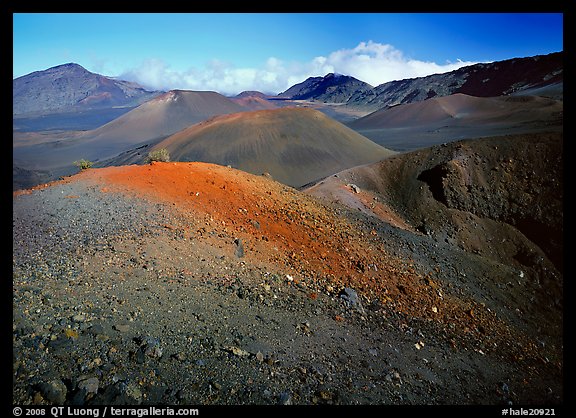Photo Spot 51: Haleakala National Park – Haleakala Crater
No Comments
Haleakala National Park, on the island of Maui, Hawaii, like Hawaii Volcanoes National Park encompasses terrain ranging from the ocean shore to the summit of a high volcano, created by the same hot spot that generated the Big Island of Hawaii.
The difference is that while the volcano on the Big Island of Hawaii exhibits plenty of activity, the fire has left Maui for a few centuries, as the Pacific plate carrying the Hawaiian islands has moved it away from the hot spot. In that relatively short amount of time, vegetation has taken root on the slopes and down to the Pacific, creating a tropical paradise, whereas the coastline near the Chain of Craters road stays absolutely bare. At the summit, erosion has carved the summit of the volcano into a grandiose crater – 3000 feet deep, 7.5 miles long, 2.5 miles wide – full of interesting shapes and colors, whereas the summit of Mauna Loa remains just a gentle slope.
Unlike the Mauna Loa summit, which requires a difficult hike, you drive to the Haleakala Crater (which despite its name was not created by an eruption). The road, route 378, has the distinction of being one of steepest in the world, rising from 2000 feet to above 10,000 feet in about 20 miles. Since it takes at least one hour and half to drive the 40 miles from Kahului, and I wasn’t too eager to get up at 3 in the morning, I chose to stay at the National Park Service campground. At 6,800 feet, the first-come, first-served campground, located in the delightful Hosmer eucalyptus grove, provides fresher air than the coastal locations.
The next day, I arrived at the visitor center almost an hour before sunrise. Some light already illuminated the sky, growing brighter quickly, as it took on wonderful hues. The crater felt immense, and lunar-like, but looked quite dark.
Although the actual temperature stayed probably slightly above freezing, it felt much colder with the fierce wind blowing. Fortunately, I had packed for this “tropical vacation” a fleece jacket, a mountaineering-grade shell, and gloves. Almost a hundred people already huddled near the visitor center to seek protection from the wind. I left them by hiking half a mile to the summit of White Hill. Since I had slept at high elevation the night before, I was well acclimatized and did not feel the effect of hiking in the thin air.
Everybody wants to experience a sunrise on the “House of the Sun”, but in fact the light is quite difficult at that time. When I looked directly east, the contrast between the sky and the portion of the crater beneath, backlit and shaded by a ridge, was too extreme to yield a good photograph even with the aid of a graduated neutral filter – which also caused a lot of flare. Instead, I pointed my camera north, creating a image all about the contrast between the brilliant pre-dawn sky, the rim beginning the receive some light, and the rest of the crater is in darkness.
Although they were difficult to see at that time, I noticed within the crater some interesting color patterns created by the ash flows that looked promising. In the morning, I did more exploration around the crater, planning for my next sunrise shot a few miles down the road, from Kalahaku, where I would on the distinctive cinder cones within the crater – with a more favorable light direction. At mid-day, I returned to the White Hill. The direct, bright light revealed the bright ash colors that the pre-dawn light had only hinted too. The image was all about those colors and patterns. I then found more of those colors by hiking down a portion of the Sliding Sands Trail in the afternoon, when the light on the crater is actually better. On that winter day, I was lucky that the view remained clear all day, as clouds often roll in as early as mid-morning.




View more images of Haleakala National Park
View more images of Haleakala Crater

